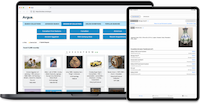Storytelling to Inspire Reflection Using Museum Collections Online

Rachael Cristine Woody
This is the final post in our series about the three major goals of using online exhibits for storytelling in museums. Doing so can be magical and impactful, whether we choose collections online as the only vehicle for storytelling or as part of a hybrid approach.
It is important for us to keep in mind the storytelling craft and to apply it regardless of physical or digital medium. Three fundamental storytelling goals from a museum exhibition perspective are engagement, learning, and reflection. Previous posts have reviewed how collections online can support museum audience engagement and use storytelling to create learning opportunities. This post will focus on reflection.
Personal Reflection: The Final Storytelling Goal
The last major goal of storytelling is to convey a story in a way that elicits personal reflection. In order to arrive at a place of potential reflection, the exhibit viewer must first successfully meet the engagement and learning goals.
This means they have engaged and understand the content, and have identified either sympathetically or empathetically with the story. With those two goals achieved, a person is then ready for reflection. Reflection occurs more typically when prompted versus being self-initiated.
How to Encourage Reflection in a Diverse Audience
Exhibits help visitors achieve reflection most effectively by offering prompts throughout the exhibit and at the end—usually after explaining a notable action or decision. Part of the challenge to achieving reflection is identifying points where prompting of individual thought would feel fairly natural. The diversity of the audience may mean they will appreciate different approaches to reflection prompts. Please note that the exhibit story will need to be completed before reflection points are identified.
The following are the common points of a story where prompts for self-reflection are the most effective:
- The first conflict, challenge, or point of adversity.
- Identification of actions or decisions that impact the protagonist or a larger cohort of people.
- The penultimate action, decision, or event that leads to the final point of adversity.
- The final challenge, issue, or event.
Thanks to the sympathy and empathy generation made possible by achieving engagement and learning goals, exhibit audiences will have fewer hurdles to arriving at points of self-reflection. Another challenge to creating effective points of reflection is creating the reflection prompts themselves. In order to account for the breadth of audience members who may view the exhibit there may need to be several versions of a reflection prompt at each reflection point of the story.
Flexibility in Collections Online Storytelling
Presenting an exhibit story online allows for a great deal of flexible path making that we can employ as we consider the different needs our visitors have for reflection prompts. As people enter and make their way through a digital exhibit there are opportunities to gather basic information on the viewer.
For example, when age-related topics and topics of interest are presented, certain story pathways and reflection prompts will be delivered on-demand based on the viewer’s input. The topics and reflection questions applicable to a child experiencing the story will be different from those directed to an adult. Delivering that “customized” story in a seamless and responsive way is more easily achievable through collections online.
Next Up: Intentional Online Elements
This concludes the series on storytelling goals and how collections online can be used to fulfill them. Next time, we’ll delve deeper into the storytelling craft and the elements to consider when weaving a narrative with collections online.

Rachael Cristine Woody
To learn more, please join us for the companion webinar Accessibility Standards for Museum Collections Online, Wednesday, July 31 at 11 a.m. Pacific, 2 p.m. Eastern. (Can’t make it? Register anyway and we will send you a link to the recording and slides afterwards). Register now.
**Disclaimer: Any in-line promotional text does not imply Lucidea product endorsement by the author of this post.
Never miss another post. Subscribe today!
Similar Posts
Exploring Self-Determinate Multiple Pathways: An Example of Digital Storytelling
Discover how self-determinate multiple pathways offer flexible interactive storytelling in museum exhibits. Learn from the Tenement Museum’s ‘Your Story Our Story.’
Digital Museum Storytelling Example: A Look at Self-Determinate Linear Pathways
Self-determinate characteristics on a linear pathway go beyond brief sidebar topics and instead offer alternative ways to navigate the linear pathway.
Digital Storytelling in Museums: The Prescriptive Linear Pathway in Action
Rachael Woody emphasizes that storytelling is key to engaging audiences with collections. One effective approach? The prescriptive linear pathway—a simple yet powerful method for guiding visitors through digital exhibits.
The CMS Digital Exhibit and Story Pathways
Digital exhibits provide powerful ways to engage audiences but choosing the right story pathway is key. Explore how different exhibit structures—linear vs. multi-pathway—shape the visitor journey.







Leave a Comment
Comments are reviewed and must adhere to our comments policy.
0 Comments